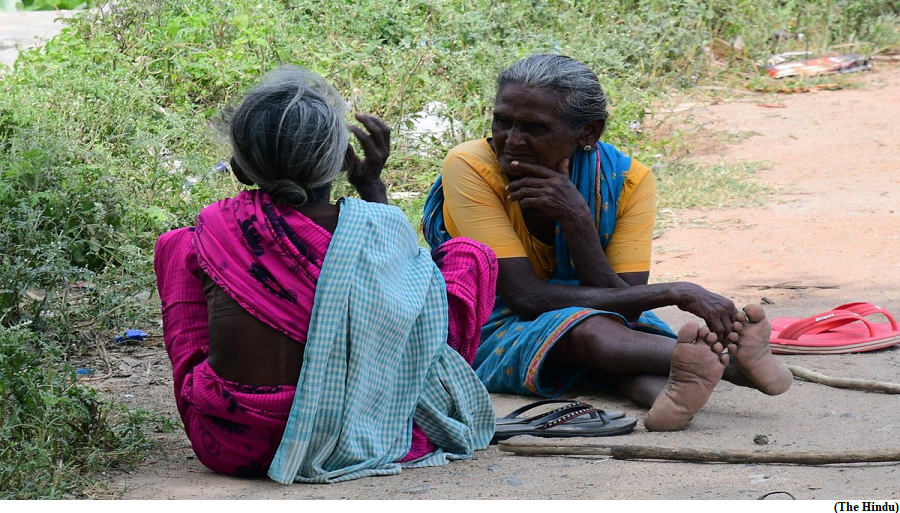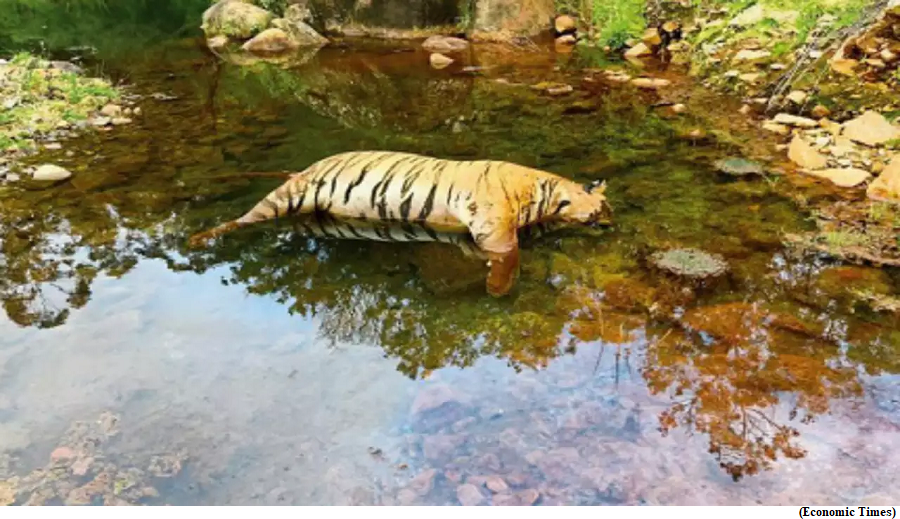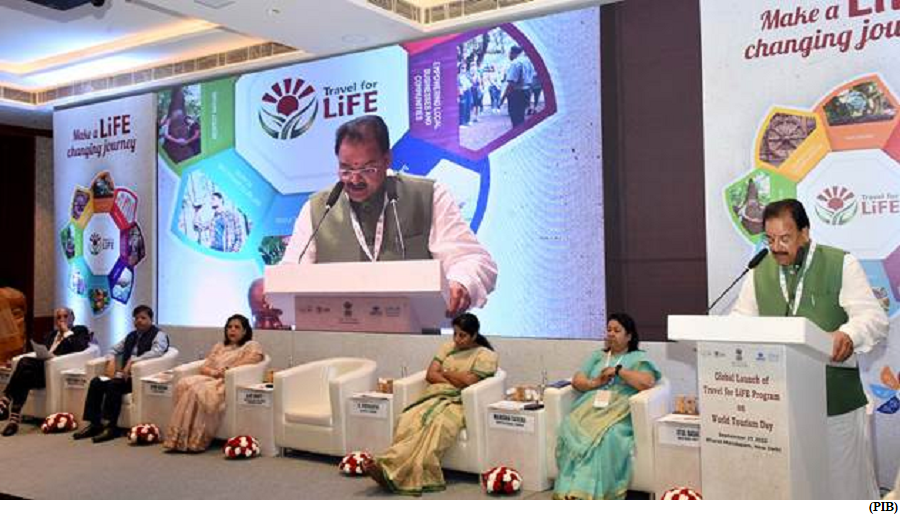India ageing, elderly to make up 20 percentage of population by 2050, UNFPA report (GS Paper 2, Social Justice)

Why in news?
- Recently, the United Nations Population Fund (UNFPA), India, released its 2023 India Ageing Report.
Details:
- With the decadal growth rate of the elderly population of India estimated at 41% and its share of the total population projected to double to over 20% by 2050, the UNFPA has said that by 2046, it is likely that the elderly population will have surpassed the population of children (aged up to 15) in the country.
- More than 40% of the elderly in India are in the poorest wealth quintile, with about 18.7% of them living without an income, such levels of poverty may affect their quality of life and healthcare utilisation.
- The report projected that the population of people aged 80 and above will grow at a rate of around 279% between 2022 and 2050 with a “predominance of widowed and highly dependent very old women”, a finding in line with the pattern across several nations.
Life expectancy:
- The data showed that women, on an average, had a higher life expectancy at the age of 60 and 80 when compared with men, with variations across the States and Union Territories.
- For instance, in Himachal Pradesh and Kerala, women at 60 have a life expectancy of 23 and 22 years, respectively, which is four years more than that of men at 60 in these States, as compared with the national average differential of only a year and a half.
- Life expectancy of women at 60 is greater than 20 years in States such as Rajasthan, Haryana, Gujarat, Uttarakhand, Kerala, Himachal Pradesh, and the Union Territory of Jammu & Kashmir, raising concerns about their social and economic well-being.
Sex Ratio:
- Further, the sex ratio (number of females per 1,000 males) among the elderly has been climbing steadily since 1991, while the ratio in the general population has been stagnating.
- Between 2011 and 2021, the ratio increased in India as a whole and across all regions, barring the Union Territories and western India.
- In the northeast and the east, while the sex ratio of the elderly increased, it remained below 1,000 in both years, indicating that men still outnumber women in these regions even at 60-plus years. This, however, is not true for the other regions (which has a bearing on the country’s average).
Major challenges:
- Poverty is inherently gendered in old age when older women are more likely to be widowed, living alone, with no income and with fewer assets of their own, and fully dependent on family for support.
- The major challenges facing India’s ageing population are the feminisation and ‘ruralisation’ of this older population and that policies must be designed to suit their specific needs.
Inter-State variation:
- There was a significant inter-State variation in absolute levels and growth (and hence, share) of the elderly population as well, reflecting the different stages and pace of demographic transition across States.
- Most States in the southern region and select northern States such as Himachal Pradesh and Punjab reported a higher share of the elderly population than the national average in 2021, a gap that is expected to widen by 2036.
- While the States reporting higher fertility rates and lagging in demographic transition, including Bihar and Uttar Pradesh, expect to see an increase in the share of the elderly population between 2021 and 2036, the level will remain lower than the Indian average.
- Compared with southern and western India, central and northeastern regions have States with younger groups as indicated by the ageing index.
Old-age dependency ratio:
- In the southern region, the old-age dependency ratio (elderly people per 100 people between 15 and 59 years) was higher than the national average at around 20 as is true of western India at 17.
- Overall, Union Territories (13) and the north-eastern region (13) reflected lower old age dependency ratios.
Tigers dying in Nilgiris district
(GS Paper 3, Environment)
Why in news?
- A total of 10 tigers (six cubs and four adults) have died in the Nilgiris since the middle of August.
- The inability of the state forest department to trace the whereabouts of the two mother tigresses has raised concerns among conservationists about the welfare of the animals.

How did the tigers die?
- The first reported tiger deaths occurred in the buffer zone of the Mudumalai Tiger Reserve (MTR) in Siriyur. After conducting a postmortem on the remains, it was believed to be died due to starvation or umbilical infection.
- The second death was of an adult tigress in the Naduvattam Range in the Nilgiris forest division with officials suspecting that the tigress died due to injuries after fighting with another animal.
- Another suspected incident of fighting is believed to have caused the death of the fourth tiger, the second adult, in the Kargudi forest range of MTR.
- In September, two more tigers were found dead in Udhagai South Range near Avalanche in the Nilgiris Forest Division.
- In a final incident, four tiger cubs were found dead over the course of three days in Kadanad in the Nilgiris North Range.
Why are conservationists concerned?
- In February 2023, the forest department arrested four poachers from Rajasthan who had allegedly poached a tiger in the areas surrounding Emerald Dam near Avalanche, a few kilometres away from where the two tigers were found dead.
- In addition, the inability of the forest department to track down the two mothers of the six tiger cubs that died in Siriyur and Kadanad has raised concerns over their well-being.
What are the reasons for the deaths?
- One of the theories put forward by forest department is that the high density of tigers in the Mudumalai-Bandipur-Nagarhole complex of the Nilgiri Biosphere Reserve is pushing populations into the surrounding habitats in the Mukurthi National Park, Nilgiris and Gudalur forest divisions.
- This leads to increased competition between animals and more fighting, resulting in more deaths.
- The Nilgiris Division is now home to 54 tigers, a significant population. In fact, tigers have been frequently recorded in the outskirts of the Udhagamandalam town multiple times over the last few years.
- Conservationists worry that this increase in population could lead to more negative human-animal interactions in the near future.
- They emphasise the need to regenerate degraded habitats that can be re-colonised by the tigers’ prey such as Sambar, spotted deer and the Indian gaur.
Way Forward:
- To allay fears that poachers could be targeting tigers, the forest department plans to set up anti-poaching camps in six forest ranges surrounding the Mukurthi National Park.
- There are also plans to begin annual monitoring of tiger populations in the Nilgiris Forest Division, with the population size, range of each individual animal and other parameters to be recorded for better management.
- They have also increased perambulation of areas surrounding key tiger habitats in Mukurthi and Mudumalai.
Ministry of Tourism, organised the Global Launch of Travel for LiFE
(GS Paper 3, Economy)
Why in news?
- On the occasion of World Tourism Day 2023, Ministry of Tourism, organised the Global Launch of ‘Travel for LiFE’, a sectoral program under Mission LiFE, targeted towards the tourism sector.
- It was launched in partnership with the Ministry of Environment, Forest and Climate Change (MoEFCC), United Nations World Tourism Organisation (UNWTO), and the United Nations Environment Programme (UNEP) at Bharat Mandapam, New Delhi.

Verticals:
- The event saw the launch of the Travel for LiFE program for two different verticals viz.
- Travel for LiFE for Cleanliness – a national TFL campaign for cleaning tourist sites and monuments in convergence with the Swachhata campaign and
- Travel for LiFE for Rural Tourism encouraging tourists to explore the rural and lesser-known hinterland promoting sustainable rural tourism thereby empowering rural communities.
SDGs:
- The ‘Travel for LiFE’ program actions promotes sustainable economic development, encourages sustainable consumption and production and thereby contributes to the SDGs focused on Decent Work and Economic Growth (SDG 8), Sustainable Cities and Communities (SDG 11), Responsible Consumption and Production (SDG 12), Climate Action (SDG 13) and Life Below Water (SDG 14). Given the wide range of actions, Travel for LiFE contributes directly and indirectly to almost all the SDGs.
Tourism for Tomorrow:
- A national Travel for LiFE competition titled as ‘Tourism for Tomorrow’ for case studies and best practices was also launched during the event, in alignment with the key priorities of Goa Roadmap.
- The ‘Tourism for Tomorrow’ Competition builds upon the five key priorities of G20 GOA Roadmap for Tourism that are Green Tourism, Digitalization, Skills, Tourism MSMEs, and Destination Management. The Ministry of Tourism will recognize and support SDG-driven Tourism Best Practices in India through the facilitation of this competition.
- A Design challenge competition for Institutes of Hotel Management affiliated to NCHMCT (National Council for Hotel Management and Catering Technology) under Ministry of Tourism, Government of India has been planned to develop innovative solutions in the field of edible cutlery.
Swachchta campaign:
- In line with the Swachchta campaign activities, a massive cleanliness drive has been planned by the Ministry of Tourism, Govt. of India at identified 108 tourist locations for the launch of the Swachhata Campaign.
- This campaign will be carried out at these 108 sites as well as other places of tourist importance.
- The objective of the whole drive is to ensure garbage cleaning, sanitation and banning Single Use Plastic (SUP) and promoting use of eco-friendly substances.
- For a wider reach, the students of schools and colleges and members of Yuva Tourism Clubs (YTC) have also been involved.
Best Rural Tourism Village Awards:
- On the occasion Best Rural Tourism Village Awards were given for promotion and preservation of their cultural heritage and sustainable development through tourism.
- 35 Rural Tourism Villages were with 5, 10, and 20 villages in Gold, Silver, and Bronze Categories respectively.




